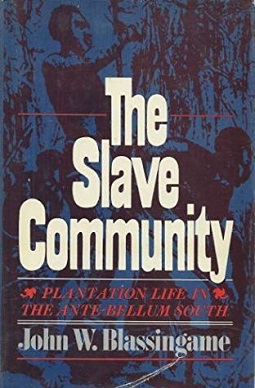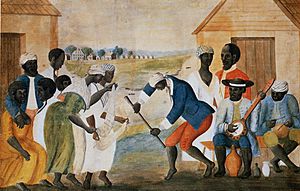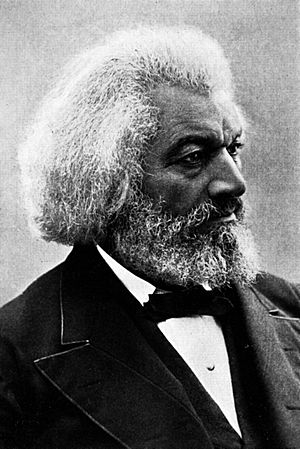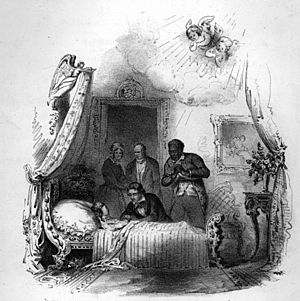The Slave Community facts for kids

First edition
|
|
| Author | John W. Blassingame |
|---|---|
| Country | United States |
| Language | English |
| Subject | Slavery in the United States History of the Southern United States |
| Published | 1972 (Oxford University Press) 1979 (rev. ed.) |
| Media type | Print (Hardcover & Paperback) |
| Pages | 262 pp. 414 pp. (rev. ed.) |
| ISBN | 0-19-502562-8 (rev. ed. hardback) ISBN: 0-19-502563-6 (rev. ed. paperback) |
| 975/.004/96073 | |
| LC Class | E443 .B55 1979 |
The Slave Community: Plantation Life in the Antebellum South is an important book by American historian John W. Blassingame. It was published in 1972. This book was one of the first studies of slavery in the United States to focus on the experiences of enslaved people themselves.
The Slave Community disagreed with earlier historians. These historians often suggested that African-American slaves were always obedient and happy. They believed slaves enjoyed a kind of "paternalistic" relationship with their masters on southern plantations. Blassingame used psychology and stories from people who had escaped slavery (called fugitive slave narratives). He showed that enslaved people developed their own independent culture. He also showed that they had many different kinds of personalities, not just one.
Even though many scholars recognized the book's importance, some historians criticized Blassingame's ideas and the sources he used. They questioned using slave narratives, saying they might not be fully reliable. They also wondered why he didn't use interviews with over 2,000 former slaves collected by the Works Progress Administration (WPA) in the 1930s. Some historians felt his use of psychology wasn't helpful. Blassingame defended his work and published a new, updated edition in 1979. Despite the criticisms, The Slave Community is still a key book for understanding the lives and culture of enslaved people in the antebellum South (the time before the American Civil War).
Contents
How Historians Studied Slavery Before
Historians have studied slavery in different ways over time. Understanding these older studies helps us see why Blassingame's book was so important.
Early Views on Slavery
Ulrich Bonnell Phillips wrote a major book about slavery in 1918 called American Negro Slavery. Phillips described enslaved people as mostly obedient and cheerful. He said their nature made them need a master's care rather than harsh control. Phillips's book included racist ideas common in the southern United States at the time. Even though African American scholars like W. E. B. Du Bois disagreed with Phillips, his book was seen as the main authority on American slavery until the 1950s.
Challenging Old Ideas
In the 1950s, new books challenged Phillips's views. Kenneth M. Stampp's The Peculiar Institution (1956) and Stanley M. Elkins's Slavery (1958) offered different perspectives. Stampp's study did not include racist ideas. He believed there were no natural differences between Black and White people. He questioned the idea that plantation owners were truly "paternalistic" (like caring fathers) towards their slaves.
Elkins also disagreed with Phillips's idea that enslaved African Americans were naturally obedient. Elkins argued that enslaved people were made to be childlike or "infantilized" by the cruel treatment they received. He compared this process to how people were treated in extreme control situations, suggesting that such harsh conditions could make people act very submissive.
New Sources for History
Like Phillips, Stampp and Elkins mainly used plantation records and writings from slave owners. Stampp even admitted that few historians asked what enslaved people themselves thought. Historians often ignored the written stories of enslaved people, like the 19th-century fugitive slave narratives. They thought these stories were unreliable because abolitionists (people who wanted to end slavery) sometimes edited them. Scholars also ignored the 2,300 interviews with former slaves collected by the WPA in the late 1930s. Historian George P. Rawick pointed out that white sources were often given more importance.
However, the 1970s brought new studies that changed how slavery was viewed. These studies focused on the enslaved person's perspective. They started using slave narratives and WPA interviews. Books like George Rawick's From Sunup to Sundown (1972) and Eugene D. Genovese's Roll, Jordan, Roll (1974) were examples. John W. Blassingame's The Slave Community was one of these important new studies.
Blassingame's Main Ideas
In The Slave Community, Blassingame argued that historians had not truly explored the lives of American slaves. He believed that by focusing only on slave owners, historians created a twisted view of plantation life. This view made it seem like enslaved people had no meaningful culture, family life, religion, or sense of self.
Blassingame said that relying on slave owner records led historians to repeat stereotypes about enslaved people. He argued that enslaved people had a lot of control over their own lives. He stated that instead of completely giving in to their masters, enslaved people kept parts of their African culture. They found self-worth in their own communities, spent time away from white supervision, and made choices for themselves.
African Culture and Slave Life
Blassingame believed that African culture was not completely lost during slavery. He said it was much stronger than historians had thought. He called these "African survivals." They appeared in folk tales, religion, music, dance, and language. He argued that keeping African culture was a form of resistance against slavery. He noted that enslaved Africans in America survived their difficult experiences without becoming completely obedient or childlike.

Blassingame also said that a unique culture developed within the enslaved community. This culture grew independently of the slave owners. He wrote that enslaved Black people created special cultural forms. These forms helped them deal with oppression, build group unity, express anger, keep hope, and feel good about themselves. These parts of their lives were often free from white control.
Many folk tales told by enslaved people came from African countries like Ghana and Senegal. These stories often featured animals. One famous example is the "tar-baby tale," which is similar to an Ewe story from Africa. Enslaved people in the South sometimes included African animals like elephants in their stories.
Even though Christian missionaries and slave owners tried to erase African religious beliefs, Blassingame found that many African religious practices blended into new forms, like voodoo. Voodoo priests offered hope for kindness from masters, protection, love, and healing. Other African religious traditions included funeral rites, grave decorating, and special dancing and singing.
Slave owners tried to stop enslaved people from making music or playing instruments. This was because drums were used to signal the Stono Rebellion in 1739. But Blassingame showed that enslaved people still built a strong musical tradition based on their African heritage. Their music, songs, and dances were similar to those in Africa. They made instruments like drums, banjos, and gourd rattles.
Blassingame also noted that cultures mixed on southern plantations. Europeans and Africans borrowed from each other. The most important example was Protestant Christianity (especially Baptist and Methodist churches). The church was a major way enslaved people learned about American culture. Christianity and Black ministers slowly replaced African religious traditions. Enslaved people used Christianity to create their own communities. While ministers might preach obedience when white people were present, enslaved people often met in secret, "invisible" services. In these "invisible churches", they could talk about freedom and God's judgment against slave owners.
Slave Families
Slave marriages were not legal in southern states. Slave couples were often separated when owners sold them. Blassingame agreed that slave owners controlled marriages. They encouraged couples to stay together, thinking it would make slaves easier to control. They believed a man who loved his family would be less likely to rebel or run away. Blassingame pointed out that if a couple lived on the same plantation, the husband might see his wife whipped or his children sold. He said nothing showed a slave's powerlessness more than not being able to stop his family from being sold.
However, Blassingame argued that even though families were often broken up, the family was key to how enslaved people survived. It helped them avoid becoming completely dependent on their masters. He explained that slave families, though different from free families, still raised children. Parents taught their children values different from what masters wanted. They helped children understand their situation and gave them a sense of self-worth.
Blassingame said that slave parents tried to protect young children from the harshness of plantation life. When children realized they were enslaved (often after their first whipping), parents taught them not to act on angry feelings like wanting to run away or get revenge.
Children saw their fathers act differently. In their living quarters, fathers might speak out against mistreatment. But in the fields, working for the master, they seemed obedient. Blassingame believed children learned both these behaviors. They saw obedience as a way to avoid punishment. They saw the behavior in the quarters as the true way to act. He concluded that the family was a vital way for enslaved people to survive. It offered love and support, helping them cope with their difficult lives.
Different Personality Types
Blassingame identified three common stereotypes of enslaved people in old Southern writings:
- Sambo was seen as a faithful, obedient, and superstitious slave.
- Jack was a loyal worker until he was mistreated. Then he became uncooperative or rebellious. He would avoid white people or act respectful in their presence.
- Nat was the runaway and rebellious slave that slave owners feared. Named after Nat Turner, this character fought back against slave owners and was only stopped by larger numbers.
Blassingame directly challenged the idea that enslaved people were "infantilized" (made childlike). He argued that historians focused too much on the Sambo personality type. He said the Sambo stereotype was so common in old Southern literature that many historians thought it was an accurate description of most enslaved people.
According to Blassingame, the Sambo figure came from white Americans' beliefs that Africans and African Americans were naturally primitive, passive, and childlike. Southern writers used Sambo to defend slavery against accusations of cruelty from people who wanted to end it. Slave owners also used the Sambo stereotype to calm their own fears about slaves rebelling. Blassingame said that because the "Nat" (rebel) figure was always a possibility, creating "Sambo" was almost necessary for white Southerners' peace of mind.
Despite the idea of slave owner "paternalism" and claims of obedience, Blassingame argued there was strong evidence of enslaved people resisting their bondage and loving freedom. He highlighted efforts by slaves to run away and rebel. These included the Stono Rebellion of 1739, Charles Deslondes's revolt in 1811, and Nat Turner's revolt of 1831. He also mentioned fugitive slaves fighting with Seminoles in Florida during the Seminole Wars. Blassingame concluded that both the Sambo and Nat stereotypes were real. He explained that the more white people feared Nat, the more they tried to believe in Sambo to avoid paranoia.
Blassingame concluded that enslaved people showed a variety of personality types. These types fell somewhere between the two extremes of Sambo and Nat. He argued that differences in plantations, overseers, and masters gave enslaved people more freedom and independence than their role as slaves suggested. He compared slavery on southern plantations to the treatment of prisoners in places of extreme control. He argued that the goal of plantations was not to systematically torture and kill laborers, who were valuable property. This meant enslaved people had more ways to survive and resist than prisoners in such extreme situations.
How Blassingame Studied Slavery
In The Slave Community, Blassingame used ideas from psychologist Harry Stack Sullivan to understand how enslaved people behaved. Sullivan's theory suggests that "significant others" (people with power to reward or punish) greatly influence behavior. Blassingame also used "role theory," which says a person's behavior is often shaped by the roles society expects them to play. He believed these theories could help historians understand how much enslaved people acted the way their masters expected.

Blassingame argued that historians had "deliberately ignored" the autobiographies of former slaves, especially the fugitive slave narratives. He relied heavily on these stories to understand the enslaved person's view of bondage. He used narratives by people like Henry Bibb, Elizabeth Keckley, Solomon Northup, and Frederick Douglass. His discussions about the African slave trade and African culture were based on Olaudah Equiano's autobiography.
Blassingame admitted that some historians questioned the reliability of these autobiographies. They felt that enslaved people, as victims, couldn't give an objective account. However, Blassingame defended his use of them. He said that the picture of slavery that came from these narratives was not just a simple "hell on earth." Instead, they showed a range of people, both Black and White, just like in any human society. He concluded that these autobiographies were valuable because they were eyewitness accounts of slave communities.
Besides slave narratives, Blassingame used abolitionist newspapers like The Liberator. These papers printed interviews, letters, and autobiographies from enslaved people. They also covered white Southerners and reprinted articles from Southern newspapers.
Blassingame chose not to use the WPA slave interviews in his original study. He felt that the heavy editing of these interviews made them harder to use than autobiographies. He explained in a 1975 article that white interviewers often removed information that didn't fit the idea of a "paternalistic" (caring) South. He warned that using these interviews without careful thought could lead to a simple and distorted view of plantations.
Blassingame built on the work of earlier historians like Phillips, Stampp, and Elkins. He also acknowledged the influence of other studies on slavery.
Updated Edition
After discussions and criticisms, Blassingame published a revised and expanded edition of The Slave Community in 1979. In the new introduction, he explained that he wanted to address the questions and challenges raised by other scholars since his book first came out.
Blassingame added more discussion about African cultural survivals, slave family life, slave culture, and how cultures mixed. He included a new chapter called "The Americanization of the Slave and the Africanization of the South." In this chapter, he compared how African American slaves in the American South adapted to new cultures with how African slaves in Latin America and European slaves in North Africa adapted. He compared their conversions to different religions, like Protestant Christianity in the South, Islam in North Africa, and Catholicism in Latin America.
In the revised edition, Blassingame also discussed other slavery studies published between 1972 and 1978. For example, he challenged the economic and statistical study of slavery in Time on the Cross by Robert Fogel and Stanley Engerman. Blassingame argued that statistics alone don't tell the whole story. He said that numbers need to be combined with personal accounts from eyewitnesses to truly understand history.
Reviewing the revised edition, Gary B. Mills noted that The Slave Community remained an important book. He agreed with Blassingame's main point: that most enslaved people and slave owners were somewhere between the extreme stereotypes.
See also
 In Spanish: La comunidad del esclavo para niños
In Spanish: La comunidad del esclavo para niños


